Our blog comes from mammal expert Derek Crawley.
Derek is a valued and active member of the Mammal Society and has also previously sat on the Society’s Council. He is currently Chair of the Staffordshire Mammal Group and a Regional Coordinator for the National Harvest Mouse Survey.

The harvest mouse is one of our smallest mammals and is the only mammal in the UK that has a prehensile tail. It wraps its tail around the stems of grasses so that it can lean out with its front paws to grab a leaf from an adjacent stem. Holding the leaf and using its teeth it splits the living leaf into two or three strips which it can then use to weave along with other leaves into a tight ball, (see below). This nest made up of living material blends in with the surrounding vegetation making it hard to find, which adds to the difficulty of establishing this mammal’s population. Currently the Mammal Society is running a national survey in order to find out their population and needs your help. To volunteer today please .

Split leaves and nest
Harvest mice like tall or tussock grass-like vegetation where they can reach between stems and build their summer breeding nest, which are a bit smaller than a tennis ball. These types of vegetation can be found in unmanaged grasslands, along hedgerows and fences or in wetland habitats where they use rushes and reeds. The nest will be located where the leaf zone is, so for cocksfoot grasses it's in the middle of the tussock (see below) or for reed canary grasses, it's about 2/3 up the stem. The nests are attached to the surrounding stems so can still be found quite easily until the end of March.

For cocksfoot grasses the nest is in the middle of the tussock
Once you have found a suitable area to survey, you need to comb through the strand of stems, parting the stems away from each other so that a nest appears. The nests of birds that breed in these areas are not weaved around grass stems and so quickly fall to the ground during winter storms, which makes them easily distinguishable from harvest mice nests. Additionally, although field vole nests are often found in between clasped stems of tall grasses and may be in a ball, they are made up of short cut sections which will fall apart if picked up, (see below). In the south of the country there can be confusion with dormice nests which also create woven spherical nests using shredded material (see below), but these are not connected to grass stems and are more likely to be found in hedgerow and bramble habitats with some tall grasses close by.

Field vole nest

Dormouse nest
It's not unheard of for one person to search an area and not find a nest, and then a different person to search the same field and find one. Remember it will be the same colour as the surrounding vegetation and so hard to spot until you get your eye in. I personally like doing surveys in a group so there is a bit of healthy competition to see who can spot the most nests. Sometimes as you are looking closely at the stems you will see where the mice may have started, but not finished, a nest. You will be able to see that the leaves have been shredded and have splits along their veins, although this shows potential presence you should err on the side of caution and find a nest to be sure. We often aim to look for tennis ball sized nests but smaller ones are also found, these are typically used by males and non breeding females. Breeding females can have 3-4 litters a year and make a new nest each litter, therefore the number of nests found does not help work out the population of harvest mice in a field!
Whilst finding a nest is worthwhile, surveying for harvest mice nests should all follow the Mammal Society’s guidelines so they can create an accurate map of the species distribution, for example the Mammal Society recommends you to look at a 200 metre square area rather than a 200 metre long fence line. Furthermore recording the type of vegetation and height of any nests found is almost as valuable as recording the nest itself, this additional information will allow the charity to recommend best practices in the future for saving this mammal.
Although we are interested in harvest mice and their nests, the surveys are a great opportunity to keep an eye out for other field signs of animals in the area. Footprints on pathways and maybe the odd fox dropping, all of these can be recorded on the free Mammal Society's and will help contribute to the conservation of Britain’s mammals.
So, good searching, and I look forward to seeing your harvest mouse survey results on the Mammal Society’s website.
